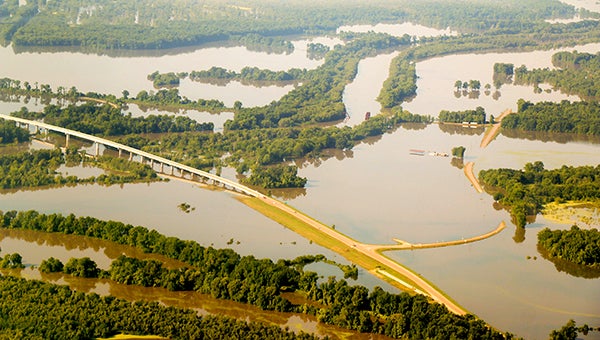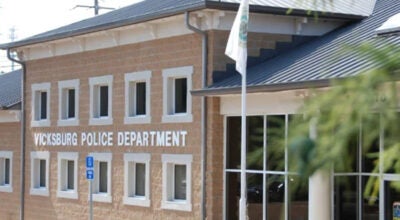Top Story of 2019: Impact from historic backwater flood and recovery shaped 2019
Published 2:30 pm Wednesday, January 1, 2020

- In this file photograph from June 2019, the intersection of Mississippi 465 and U.S. Hwy. 61 North can be seen in the foreground. The bridge to the left is the Yazoo River Bridge. Normally, the Yazoo would be the only water seen. (Walter Frazier | For The Vicksburg Post)
The flood of 2019 has been called many things: disastrous, record-setting and eye-opening.
It displaced people from their homes, denied farmers the opportunity to plant crops, and produced a major fundraising effort to help those affected by the disaster.
The Mississippi River at Vicksburg stayed above flood stage for 150 days. The Yazoo Backwater Area was inundated for 219 days, as water from excessive rainfall in the area was unable to drain off and pooled, reaching 98.2 feet in May, breaking a 40-year-old record of 96.5 feet in 1979, and the Eagle Lake community flooded for only the second time since 1973.
During the 2019 flood, 686 homes flooded, 231,000 acres of cropland were underwater and never planted, 548,000 total acres were flooded, three highways went underwater, and two people died.
What made it historical was its duration, said Drew Smith, chief of the Water Management Section for the U.S. Army Corps of Engineers Vicksburg District.
“We haven’t seen anything anywhere near this long as far as the Mississippi River above flood stage since 1927; we’re in about 20 or so days of Vicksburg being above flood stage for the 1927 event,” he said.
Another element was flooding from other basins that contributed to the 2019 flooding in this area.
“In February and March, you had a flood coming off the Ohio,” Smith said. “In March you had above average rain in the upper Mississippi River Basin, in April, you had well above average rain in the upper Mississippi and the Missouri River Basin, in May you had a record flood of Arkansas.
“Every time we would get those flows to pass through the lower valley and it would start to peak and crest, another basin would get heavy rain and would keep the river up and prevent it from falling. We had four or five distinct peaks on the Mississippi River this year, all above flood stage, which is very, very rare; we’ve only seen it in 1927.”
The high water on the Mississippi forced the Corps to close the gates at the Steele Bayou Control Structure, trapping water in the backwater area, and the rainfall the area received from February through July contributed to the already impounded water, causing it to rise and threaten Eagle Lake and other area control structures.
The flood’s effect on residents in the northern part of Warren County inspired other residents to contribute money to assist the victims, and United Way of West Central Mississippi served as the clearing house for relief donations.
The call for aid also led to Floodfest, a major fundraising effort to assist people affected in the Yazoo Backwater area that included vendors, classic cars and tractors along with fire equipment, law enforcement vehicles, 18-wheelers and military vehicles.
In December, U.S. Sen. Cindy Hyde-Smith announced the passage of the federal spending bill which included more than $300 million for the Corps to be used in flood-mitigation programs including support for the backwater pumps, which many believed had they been installed — as planned more than 70 years ago — would have curtailed as much as half of the flooding.





